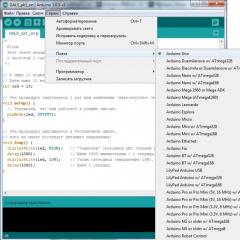Resonances in electrical circuits. Territory of electrical information WEBSOR Resonance in an electrical circuit definition
In physics, resonance is a phenomenon in which the frequency of free oscillations in an oscillatory circuit coincides with the frequency of forced oscillations. In electricity, an analogue of an oscillatory circuit is a circuit consisting of resistance, capacitance and inductance. Depending on how they are connected, they distinguish voltage resonance and current resonance.
Voltage resonance occurs in a series RLC circuit.
The condition for the occurrence of resonance is the equality of the frequency of the power source to the resonant frequency w=w p, and hence the inductive and capacitive resistances x L =x C . Since they are opposite in sign, the resulting reactance will be zero. The voltages on the coil U L and on the capacitor U C will be opposite in phase and cancel each other out. The total resistance of the circuit in this case will be equal to the active resistance R, which in turn causes an increase in the current in the circuit, and hence the voltage on the elements.
At resonance, the voltages U C and U L can be much larger than the voltage, which is dangerous for the circuit.

As the frequency increases, the resistance of the coil increases, and the resistance of the capacitor decreases. At the time when the source frequency is equal to the resonant one, they will be equal, and the circuit impedance Z will be the smallest. Therefore, the current in the circuit will be maximum.

From the condition of equality of inductive and capacitive resistances, we find the resonant frequency

Based on the written equation, we can conclude that resonance in the oscillatory circuit can be achieved by changing the frequency of the source current (frequency of forced oscillations) or by changing the parameters of the coil L and the capacitor C.
You should be aware that in a series RLC circuit, the exchange of energy between the coil and the capacitor is carried out through a power source.
Current resonance occurs in a circuit with a resistor and a capacitor connected in parallel by a coil.

The condition for the occurrence of current resonance is the equality of the source frequency to the resonant frequency w=w p, hence the conductivity B L =B C . That is, at resonance of currents, capacitive and inductive conductances are equal.
For clarity of the graph, for a while we digress from conductivity and move on to resistance. As the frequency increases, the circuit impedance increases and the current decreases. At the moment when the frequency is equal to the resonant one, the resistance Z is maximum, therefore, the current in the circuit takes the smallest value and is equal to the active component.

We express the resonant frequency
 As can be seen from the expression, the resonant frequency is determined, as in the case of voltage resonance.
As can be seen from the expression, the resonant frequency is determined, as in the case of voltage resonance.
Resonance phenomenon. An electrical circuit containing inductance and capacitance can serve as an oscillatory circuit, where the process of oscillations of electrical energy occurs, passing from inductance to capacitance and vice versa. In an ideal oscillatory circuit, these oscillations will be undamped. When connecting the oscillatory circuit to the source alternating current source angular frequency? can be equal to the angular frequency? 0 , with which electric energy fluctuates in the circuit. In this case, the phenomenon of resonance takes place, i.e., the coincidence of the frequency of free oscillations? 0 arising in any physical system, with the frequency of forced oscillations?, communicated to this system by external forces.
Resonance in electrical circuit can be obtained in three ways: by changing the angular frequency? AC source, inductance L or capacitance C. Resonance is distinguished when L and C are connected in series - voltage resonance and when they are connected in parallel - the resonance of currents. corner frequency? 0 at which resonance occurs is called resonant, or natural frequency of oscillation of the resonant circuit.
Stress resonance. At voltage resonance (Fig. 196, a), the inductive reactance X L is equal to the capacitive X c and the impedance Z becomes equal to the active resistance R:
Z \u003d ? (R 2 + [? 0 L - 1 / (? 0 C)] 2) \u003d R
In this case, the voltages on the inductance U L and capacitance U c are equal and are in antiphase (Fig. 196, b), therefore, when added, they cancel each other out. If the active resistance of the circuit R is small, the current in the circuit increases sharply, since the reactance of the circuit X = X L -X s becomes zero. In this case, the current I is in phase with the voltage U and I=U/R. A sharp increase in current in the circuit during voltage resonance causes the same increase in voltages U L and U c, and their values \u200b\u200bare many times higher than the voltage U of the source supplying the circuit.
The angular frequency?0, at which the resonance conditions take place, is determined from the equality ? o L \u003d 1 / (? 0 C).
Hence we have
? o = 1/?(LC) (74)
If you smoothly change the angular frequency? source, then the impedance Z first begins to decrease, reaches its lowest value at voltage resonance (at? o), and then increases (Fig. 197, a). In accordance with this, the current I in the circuit first increases, reaches its maximum value at resonance, and then decreases.
Resonance of currents. Current resonance can occur when inductance and capacitance are connected in parallel (Fig. 198, a). In the ideal case, when there is no active resistance in the parallel branches (R 1 \u003d R 2 \u003d 0), the condition for current resonance is the equality of the reactances of the branches containing inductance and capacitance, i.e. ? o L = 1/(? o C). Since in the case under consideration the active conductivity G = 0, the current in the unbranched part
circuits at resonance I \u003d U? (G 2 + (B L -B C) 2) \u003d 0. The values of the currents in the branches I 1 and I 2 will be equal (Fig. 198, b), but the currents will be phase-shifted by 180 ° (the current IL in the inductance lags behind the voltage U by 90 °, and the current in the capacitance I c leads voltage U by 90°). Consequently, such a resonant circuit represents an infinitely large resistance for the current I and no electrical energy enters the circuit from the source. At the same time, currents I L and I c flow inside the circuit, i.e., there is a process of continuous energy exchange inside the circuit. This energy is transferred from inductance to capacitance and vice versa.
As follows from formula (74), by changing the values of capacitance C or inductance L, it is possible to change the oscillation frequency? 0 electrical energy and current in the circuit, i.e., tune the circuit to the required frequency. If there were no active resistance in the branches in which the inductance and capacitance are turned on, this process of energy oscillation would continue indefinitely, i.e., undamped oscillations of energy and currents I L and I s would arise in the circuit. However, real inductors and capacitors always absorb electrical energy (due to the presence of active wire resistance in the coils and the occurrence
in capacitors of bias currents that heat the dielectric), therefore, in the real circuit at resonance of the currents, some electrical energy comes from the source and some current I flows through the unbranched part of the circuit.
The resonance condition in a real resonant circuit containing active resistances R 1 and R 2 will be the equality of reactive conductances B L = B C of the branches, which include inductance and capacitance.
From fig. 198, in it follows that the current I in the unbranched part of the circuit is in phase with the voltage U, since the reactive currents 1 L and I c are equal, but opposite in phase, as a result of which their vector sum is zero.
If in the considered parallel circuit to change the frequency? about an alternating current source, then the impedance of the circuit begins to increase, reaches its maximum value at resonance, and then decreases (see Fig. 197, b). In accordance with this, the current I begins to decrease, reaches the lowest value I min = I a at resonance, and then increases.
In real oscillatory circuits containing active resistance, each current oscillation is accompanied by energy losses. As a result, the energy imparted to the circuit is consumed quite quickly and the current fluctuations gradually die out. To obtain undamped oscillations, it is necessary to replenish energy losses in the active resistance all the time, i.e., such a circuit must be connected to an alternating current source of the appropriate frequency? 0 .
The phenomena of voltage and current resonance and the oscillatory circuit have been widely used in radio engineering and high-frequency installations. With the help of oscillatory circuits, we obtain currents high frequency in various radio devices and high-frequency generators. Oscillatory circuit- the most important element of any radio receiver. It ensures its selectivity, i.e., the ability to isolate from radio signals with different wavelengths (i.e., with different frequencies) sent by various radio stations, the signals of a specific radio station.
In the event that the electrical circuit contains elements with capacitive as well as inductive properties, a resonance mode may occur. In addition, resonance in an electrical circuit appears when the current and voltage are in phase. Input reactance and conductance are zero. There is no phase shift at all and the circuit becomes active.
Causes of resonance
Voltage resonance appears in the case of a series connection of sections containing inductive and capacitive resistances, as well as resistors. Such a simple circuit is often referred to as a series or parallel circuit.
In the resonant circuit, the presence of resistive resistance is not at all necessary. However, it must be taken into account when determining the resistance of conductors. Thus, the resonant mode completely depends on the parameters and properties of the electrical circuit. It is not affected in any way external sources electrical energy.
In order to determine the conditions under which the resonance mode occurs, it is necessary to check the electrical circuit in order to determine its conductivity or complex. In addition, its imaginary part must be selected and equated to zero.
Resonance Characteristics
All parameters included in the circuit and present in the resulting equation, one way or another, affect the indicators characterizing the resonance phenomena. Depending on the parameters included in the equation, the solution may have several different options. At the same time, all solutions will correspond to their own version and in the future acquire physical meaning.
In various types of electrical circuits, the resonance phenomenon is considered, as a rule, in the analysis in the case of several options. In the same cases, circuit synthesis can be carried out, in which resonance parameters are predetermined.
Electrical circuits that have a large number of connections and reactive elements,  represent a major problem in analysis. They are never used in synthesis with predetermined properties, since it is far from always possible to obtain desired result. Therefore, in practice, bipolar devices of the simplest designs are studied and, based on the data obtained, more complex circuits with predetermined parameters are created.
represent a major problem in analysis. They are never used in synthesis with predetermined properties, since it is far from always possible to obtain desired result. Therefore, in practice, bipolar devices of the simplest designs are studied and, based on the data obtained, more complex circuits with predetermined parameters are created.
Thus, the resonance of an electrical circuit is a rather complex phenomenon, due to the use of certain elements in it. Accounting for this phenomenon allows you to most fully determine the parameters and other characteristics.
Resonances of currents and voltages



